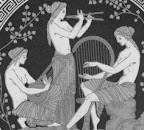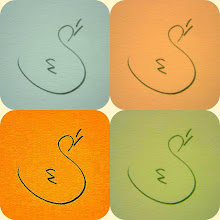2009年6月28日 星期日
告別童年的「圓舞曲」
原刊載於yahoo的【心象藝術的部落格】,分類:音樂漫談 (2007/01/02 00:59)


2009年6月24日 星期三
2009年6月20日 星期六
高第建築藝術的音樂聯想
「建築是凝固的音樂」、「音樂是流動的建築」,我想這兩句話大家一定不陌生,但是,真的是這樣嗎?在你心中可曾質疑過?或許就是因為這份質疑,讓學音樂的我對建築自然地產生了興趣,也因此意外地享受到更多美的訊息。
2006年的八月初,曾走訪了一趟國父紀念館,為的是一睹西班牙建築大師高第(Antoni Gaudi,1852 – 1926)的建築藝術展。在展覽的作品中,我看見了飽含動能的自然曲線、繁複細緻的裝飾、簡樸的自然工法、紮實精煉的工藝技術,也看見了亮眼奇幻的色彩和夢幻的童趣,總的來說,在他的作品中可以深刻地感受到自然界神奇的蘊藏。就拿目前建築師群力拼在西元2020年完工的跨世紀建築巨作「聖家堂」來看,它就是一棟融合大自然的教堂,高第不僅將自然當作平面裝飾的一部分,在大殿內也意圖營造出森林的氛圍,他在支柱與支柱間設置光的開口,使光線的投射猶如陽光自樹葉間灑下般,自然地將所有的柱子都幻化成樹幹及樹枝,讓人有回歸自然的感受。
高第建築風格中的許多特質都引發了我對巴洛克時期的音樂聯想,尤其那取自於大自然源源不絕的創意,聯想的線就奇妙地搭上了義大利作曲家韋瓦第(Antonio Vivaldi,1678 – 1741)的 小提琴協奏曲《四季》。這是一組由四首協奏曲組成的作品,曲名分別是「春」、「夏」、「秋」、「冬」,而每首協奏曲各有三個樂章,都是遵循著「快─慢─ 快」的基本結構速度,樂曲的內容則是對照了一段段足以喚起不同季節記憶的十四行詩,這其中描述著人因季節產生的生理變化、應時活動與情感表現,還有自然界 的蟲鳴鳥叫、小河潺潺、閃電雷鳴、夏日冰雹、微風吹拂、暴風雪呼嘯以及自然與人、物的互動等種種現象,堪稱是標題音樂中的曠世傑作。
巴洛克代表著一個風格華麗、裝飾、講究對比、喜愛即興和數字低音的時代,強調動感與戲劇性可說是巴洛克音樂的總結,當然這樣的音樂風格在韋瓦第的《四季》中也處處可尋。你可以聽見許多「對比」手法的運用,例如:樂章間「快─慢─快」的速度變化;獨奏(Solo)與全體樂團(Tutti)或獨奏群(Soli)與全體樂團的交替競奏;強奏與弱奏的力度對比等精心鋪成所營造出的戲劇張力。由於韋瓦第的《四季》非常流行,你可能聽過多種的音樂版本,也可能已經發現不同的版本有著非常不同的詮釋,嗨!不要納悶,這就是巴洛克音樂的特色,而問題主要是出在〝數字低音〞(Basso Continuo),如果可以,去圖書館借出《四季》的樂譜看看,你會在低音聲部下方發現一些小小的數字,這是一種樂譜的速記法,用數字記載和絃性質,需要受過訓練的演奏家,才有能力根據數字低音去作即興演奏及裝飾曲調等變化,還有,數字低音的樂器組成是很彈性的,通常由能奏出和聲的樂器(如大鍵琴、管風琴、魯特琴)來擔任演奏,而最標準的是由一部大鍵琴和一把古大提琴所組成,百變的音樂詮釋多半是因為這樣來的,很有趣吧!
作曲家們創作的過程就好比在樂譜上蓋房子般,他們運用了自然界各種素材與靈感,結合了美的原則,建構出令人讚嘆的音樂作品,這和建築師的創作有著異曲同工之妙,除此之外,音樂和建築還有什麼樣的關聯呢?如果你曾感受到音樂流動在不同的建築空間中所營造出的不同美感經驗,那麼,你應該會有更多的領悟吧!
(作者:牟善如 2006.08.14)
【危險心靈】- 快樂頌篇
快樂頌(Ode To Joy)
作詞:佚名 / 原曲:貝多芬
編曲:侯志堅 / 演唱者:O.Joy
♫ 西班牙文歌詞:
el canto alegre del que espera un nuevo dia
ven, canta, suena canta ndo
vive sonando un nuevo sol
en quwl los hombers volveran a ser hermanos
♫ 中文詞意:
聽著我的兄弟唱著快樂的歌
這歡喜的旋律渴望著新的一天
來唱吧 來夢想 一起唱吧
讓我們擁有一個新希望
四海之內皆兄弟
▓ 相關文章:老酒「快樂」裝新瓶
2009年6月15日 星期一
Beethoven's Ode to Joy - Part 3/3
1972 Leonard Bernstein/VPO - Beethoven's Ninth Symphony
Vid 3. Contrapuntal union of Ode to Joy and "Church" theme, set of lyrical cadenzas, prestissimo finale
Leonard Bernstein conducts the Vienna Philharmonic in Beethoven's Ode to Joy. This is the final part of the piece, which contains the incredible Prestissimo Finale.
This portion of the movement begins with the contrapuntal union of the Ode to Joy and the Church Theme from the previous clip by the full chorus.
After the choral fugue, the soloists return in a lighter, more carefree rendition of the Ode to Joy theme (2:32). Seizing on their excitement, the chorus join the soloists in the song of joy (3:10). Soon, however, the chorus falls silent as the soloists reflect one final time on the divine inspiration for joy and brotherhood with heart-rendingly beautiful cadenzas (4:13).
These cadenzas lead us to the Prestissimo finale. After a silence and a quick crescendo of strings (5:18-5:27), the entire cast, every chorus member and every player down to the triangle, launches into the finale with guns blazing. After one more interruption by a gigantic, surreal Maestoso (6:14-6:37), the orchestra charges full speed ahead to the final cadence.
▓ 以上資料來源:ernestalba (2007/4/21)
▓ 相關文章:老酒「快樂」裝新瓶
Beethoven's Ode to Joy-Part 2/3
1972 Leonard Bernstein/VPO - Beethoven's Ninth Symphony
Vid 2. Tenor solo, Instrumental passage, Ode to Joy 1st verse - Choral, second "Church" theme
It is structurally divided into four components.
1. A Turkish March with a tenor solo. (0:00-1:50)
2. A breathtaking instrumental double fugue. (1:51-3:22)
3. A reprise of the famous first verse. (3:23-4:35) (This is one of the most dramatic and celebrated parts of the Ninth.)
4. A new sacred theme different from the Ode to Joy. (4:37-8:44)
words and translation:
Allegro assai vivace
#1: Turkish March
Tenor:
Froh, froh, wie seine Sonnen
Happily, happily, like his suns
seine Sonnen fliegen, froh,
flying like his suns, happily,
wie seine Sonnen fliegen
flying like his suns
Durch des Himmels prächt'gen Plan,
Through Heaven's splendid firmament,
Laufet, Brüder, eure Bahn,
Run, Brothers, your course.
Laufet, Brüder, eure Bahn,
Run, Brothers, your course.
Freudig, wie ein Held zum
Joyfully, like a hero towards victory.
Wie ein Held zum
Like a hero towards victory.
Laufet, Brüder, eure Bahn.
Run, Brothers, your course.
Choral 1st Tenor, 2nd Tenor, and Bass:
Laufet, Brüder, eure Bahn.
Run, Brothers, your course.
Freudig, wie ein Held zum
Joyfully, like a hero towards victory.
(Solo Tenor re-enters)
Wie ein Held zum
Like a hero towards victory.
Freudig, freudig, freudig,
Joyfully, joyfully, joyfully
Wie ein Held zum
Like a hero towards victory.
#2: Instrumental Double Fugue
#3: Reprise of First Verse
Entire Chorus:
Freude, schöner Götterfunken
Joy, beautueous spark of divinity,
Tochter aus Elysium,
Daughter of Elysium
Wir betreten feuertrunken,
We enter drunk with fire
Himmlische, dein Heiligtum!
Heavenly One, your sanctuary!
Deine Zauber binden wieder
Thy magic power reunites,
Was die Mode streng geteilt;
All that custom has strictly divided
Alle menschen werden Brüder,
All men become brothers
Wo dein sanfter Flügel weilt.
Where your gentle wing abides.
Deine Zauber binden wieder
Thy magic power reunites,
Was die Mode streng geteilt;
All that custom has strictly divided
Alle menschen werden Brüder,
All men become brothers
Wo dein sanfter Flügel weilt.
Where your gentle wing abides.
Andante Maestoso #4: Church Theme
Choral Tenor and Bass:
Seid umschlungen, Millionen!
Be embraced, you millions!
Diesen Kuss der ganzen Welt!
This kiss is for the whole world!
All Chorus:
Seid umschlungen, Millionen!
Be embraced, you millions!
Diesen Kuss der ganzen Welt!
This kiss is for the whole world!
Choral Tenor and Bass:
Brüder! über'm Sternenzelt
Brothers! over the starry canopy
Muss ein lieber Vater wohnen.
Must a loving father dwell.
All Chorus:
Brüder! über'm Sternenzelt
Brothers! over the starry canopy
Muss ein lieber Vater wohnen.
Must a loving father dwell.
(quietly) Ihr stürzt nieder, Millionen?
Do you prostrate yourselves, you millions?
Ahnest du den Schöpfer, Welt?
Do you sense the Creator, world?
Such ihn über'm Sternenzelt!
Seek him beyond the starry canopy!
Über Sternen muss er wohnen!
Beyond the stars he surely must dwell!
Über Sternen muss er wohnen!
Beyond the stars he surely must dwell!
▓ 以上資料來源:ernestalba (2007/4/21)
▓ 相關文章:老酒「快樂」裝新瓶
Beethoven's Ode to Joy-Part 1/3
1972 Leonard Bernstein/VPO - Beethoven's Ninth Symphony
Vid 1. Ode to Joy - Instrumental, Baritone solo, Ode to Joy - Choral
Leonard Bernstein with the Vienna Philharmonic performs Beethoven's Ode to Joy. Notice how dramatic his conducting is; it's pretty funny. Because of Youtube limitations, I split this piece up into 3 sections. This is Part 1/3. I highly recommend sticking around for the famous choral reprise of the first verse in Part 2/3 and the incredible prestissimo finale in Part 3/3.
Soloists are Gwyneth Jones, Shirley Verrett, Placido Domingo, and Martti Talvela.
This first video clip is divided into the following sections:
0:00-3:36 Bernstein's introduction
1:27-2:15 The Ode to Joy played solemnly by Cello and Contrabass
2:15-3:04 A lighter, sweeter variation now including Viola and Bassoon
3:04-3:51 Larger, more expressive second variation with addition of 1st and 2nd Violins
3:52-4:38 Triumphant and majestic third variation utilizing entire orchestra. Instruments added: Flute, Oboe, Clarinet, contrabassoon, cornet, trombone, and timpani
4:39-5:31 Dizzying flight of passion including the brief introduction of a blithe tune that is almost immediately interrupted by a thunderous cadence
5:33-6:30 The bass introduces the chorus to the audience
6:30-9:17 The Ode to Joy theme is now replayed with the significant inclusion of the chorus singing Schiller's poem.
German words and English translation:
Baritone Solo:
O Freunde, nicht diese Töne!
Oh friends, not these sounds!
Sondern lasst uns angenehmere
Rather let us sing more
anstimmen und freudenvollere.
pleasant ones, and more full of joy.
Choral Bass join in:
Freude! Freude!
Joy! Joy!
Baritone Solo:
Freude, schöner Götterfunken
Joy, beautueous spark of divinity,
Tochter aus Elysium,
Daughter of Elysium
Wir betreten feuertrunken,
We enter drunk with fire
Himmlische, dein Heiligtum!
Heavenly One, your sanctuary!
Deine Zauber binden wieder
Thy magic power reunites,
Was die Mode streng geteilt;
All that custom has strictly divided
Alle menschen werden Brüder,
All men become brothers
Wo dein sanfter Flügel weilt.
Where your gentle wing abides.
Chorus sans Soprano:
Deine Zauber binden wieder
Thy magic power reunites,
Was die Mode streng geteilt;
All that custom has strictly divided
Alle menschen werden Brüder,
All men become brothers
Wo dein sanfter Flügel weilt.
Where your gentle wing abides.
Solo Alto, Tenor, and Baritone sans Soprano:
Wem der grosse Wurf gelungen,
Whoever has been so fortunate,
Eines Freundes Freund zu sein;
To be the friend of a friend
Solo Soprano enters, Alto, Tenor, and Baritone continue:
Wer ein holdes Weib errungen,
He who has obtained a dear wife,
Mische seinen Jubel ein!
Add his jubilation!
Ja, wer auch nur eine Seele
Yes, whoever also one soul
Sein nennt auf dem Erdenrund!
Can call his own in the earthly round!
Und wer's nie gekonnt, der stehle
And who never could, he should steal
Weinend sich aus diesem Bund!
Weeping from this fellowship!
All Chorus responds (Bass one beat ahead):
Ja, wer auch nur eine Seele
Yes, whoever also one soul
Sein nennt auf dem Erdenrund!
Can call his own in the earthly round!
Und wer's nie gekonnt, der stehle
And who never could, he should steal
Weinend sich aus diesem Bund!
Weeping from this fellowship!
Tenor and Baritone:
Freude trinken alle Wesen
All beings drink joy
An den Brüsten der Natur;
At the breasts of Nature;
Alto enters:
Alle Guten, alle Bösen
All things good, all things evil
Folgen ihrer Rosenspur.
Follow her rosy trail.
Soprano enters:
Küsse gab sie uns und Reben,
Kisses gave she us and wine,
Einen Freund, geprüft im Tod;
A friend, proven even in death;
Wollust ward dem Wurm gegeben,
Ecstasy is granted even to the worm
Und der Cherub steht vor Gott.
And the cherub stands before God
All Chorus responds:
Küsse gab sie uns und Reben,
Kisses gave she us and wine,
Einen Freund, geprüft im Tod;
A friend, proven even in death;
Wollust ward dem Wurm gegeben,
Ecstasy is granted even to the worm
Und der Cherub steht vor Gott.
And the cherub stands before God
Und der Cherub steht vor Gott.
And the cherub stands before God
(Alto a beat ahead) steht vor Gott.
vor Gott.
vor Gott.
▓ 以上資料來源:ernestalba (2007/4/11)
▓ 相關文章:老酒「快樂」裝新瓶
2009年6月14日 星期日
樂聞樂思/到建中 賣打果汁機
【聯合晚報╱焦元溥】2009.06.14 01:25 pm
據報載,抗癌三年的樞機主教單國璽日前抱病前往建中,與周大觀全球熱愛生命獎章得主戈特里布(Daniel Gottlieb)展開生命對談。可嘆許多學生睡的睡、倒的倒,和台上演講者對生命與人類的熱愛關懷成為諷刺對比。報導一出,許多人自然大罵建中學生欠缺 教養,對演講者毫無尊重。
雖然只是一顆小蔥,筆者去年也受邀至建中演講,而那場面的確相當可怕。從台上望去,學生多在聊天睡覺,還有人忘情睡成大字,十足不給面子。在那種情況下演講,簡直度秒如年。
好不容易講完,出乎意料,幾位對古典音樂特別有興趣的同學跑到後台,說:「我們真的很怕你剛剛講到一半,麥克風一摔就走。」
原 來建中週會演講,來賓氣到走人已是家常便飯。真是學生全無教養嗎?未必。在建中室內球場演講,再配上那套麥克風與播音系統,大概只有前十排的同學能夠聽 清楚演講者說些什麼,之後就一團模糊。演講中我放了巴爾托克《管弦樂團協奏曲》第五樂章當例子,台下同學聽來,卻「根本和打果汁機的聲音沒有兩樣」。要同 學聽打果汁機運轉,還要期待他們保持專注清醒,或許也是稍苛的考驗了。
但 為什麼一所台灣著名學府,對聲音竟然如此輕忽?或許我們不該單問建中,而該檢討為何大家對吃穿很講究,許多人甚至不惜追逐奢華名牌,但何以到現在,我們 對聲音仍可漠不關心?台灣近年來的戶外音樂會或大型場館演出,播音之爛常是罄竹難書,但聽眾似乎不以為意,音效如大聲公般的音樂會還是有人買單。我們有發 出怪音的國家音樂廳,冷氣運轉吵到蓋過弱音演奏的台中中山堂,還有一堆座椅發出嘎嘎怪響的大小場館,但問題總是存在,噪音理所當然,無論是學校教育或社會 教育,聲音永遠不在考慮之內,台灣人也活該和聽覺垃圾為伍。
我一直很感謝建中演講當天在模糊聲音中仍保持專注,到最後還舉手參加有獎徵答,或到後台提問的同學。祝福他們,也希望他們的學弟能有良好的聽講空間,聲音與音樂終能成為基本的生活與美感要求。
▓ 本文轉載自【2009/06/14 聯合晚報】http://udn.com/NEWS/READING/REA8/4961569.shtml
2009年6月13日 星期六
老酒「快樂」裝新瓶
公視八點檔電視劇「危險心靈」的片尾曲,在網站上掀起了一些話題,多數的人似乎都喜歡這段音樂,不知道你聽過了嗎?感覺如何?還記得第一次看到這齣 戲的預告片時,一股莫名的吸引力油然而生,應該就是那段聽起來既熟悉卻又有點陌生的配樂所引起的,熟悉的「快樂頌」曲調,以舒緩的速度和著陌生的歌詞,是 一種「異國」情調吧,吟唱著說不清的淡淡新愁。
上網找到了歌詞,原來是西班牙文,看過了譯詞,發現仍不脫席勒原詩那「四海之內皆兄弟」的意涵,但為什麼聽起來就少了那份激情與歡樂呢?隨之,記憶的資料庫被打開了,映入眼簾的是一群快樂遠足的小孩,輕快高唱著「青天高高、白雲飄飄、太陽當空在微笑,枝頭小鳥…」,一樣的曲調響在腦海,卻因為不一樣的歌詞與音樂速度,而散發出另一種赤子的單純快樂。
暫且不論歌詞的表述,這個曲調本身的魅力究竟何在?為何讓人一下子就能朗朗上口且牢牢地記住,不仿就跟著下列的簡譜唱唱,看看你發現了什麼?
你發現了嗎?這個曲調可分為4個樂句,其中第2句和第4句的旋律是一樣的,而第1句第2句的不同也只在最後一小節,曲調的重複性高是易學好記的關鍵,再看看音與音的銜接,多是使用級進音程,只在第三句出現了少數的跳進音程,甚至你還可以算一算,整個音域只用了八度呢,這應該就是朗朗上口的關鍵了。
這樣的曲調來自貝多芬,當他23歲讀到了席勒那首熱烈盼望人類自由與幸福的「快樂頌」(Ode an die Freude)時,就深深地感動,為其譜曲的意圖整整琢磨了30年,最後才呈現在第九號交響曲的第四樂章中。首演發生在1824年 的維也納,當時的聽眾反映熱烈空前,高達五次的鼓掌歡呼,甚至遭到了警察的干涉制止,然而,站在樂隊中背對著聽眾的貝多芬卻什麼也聽不見,直到女低音歌手 牽著他的手轉過身,才「看到」了聽眾的歡呼。很難想像吧!一個完全失聰的音樂家用心靈譜出的樂曲,竟然可以引起那樣異乎尋常的感動。不禁使人聯想起兩德統 一的那天,德國人就在布蘭登堡門上演出同樣的樂曲,來表達統一的歡欣鼓舞,更別忘了,它在2004年還被選為歐盟的盟歌呢!當音樂響起時,二十五個會員國,四億五千五百萬人,結成了一個新的命運共同體,寓涵的意義是何等深切呀!
貝多芬第九號交響曲的創作手法,三言兩語是說不清的,在交響曲中放入份量相當的聲樂與器樂交融,在當時是絕對獨特的創意,而「快樂頌」這個簡單平易的曲調,在擅長於作動機發展的貝多芬手上,展現得精采絕倫,你可以在其中聽見語重心長的激情、天真浪漫的歡樂、如星空般的音響…,還有深深期盼的祝福。
回頭談談電視劇「危險心靈」的片尾曲,這首「快樂頌」曲調雖然源自貝多芬,但音樂傳達的詩意卻已明顯不同了,除了舒緩的彈性速度與節奏,還加上使用比貝多 芬低三度的調性,尤其那以小調開始的和絃雖然最後游回到大調,但其所帶出的愁緒仍持續瀰漫在整首樂曲中,或許這就是它吸引人的重要關鍵。其實,許多耳熟能 詳的曲調都曾被作曲家拿來當素材,重新利用而產生了新的意義,就好比是新瓶裝了老酒,細細品嚐起來,別是一番滋味在心頭。
♫ 音樂小補帖:
1. 級進音程:音與音之間的進行,無論是上升或下降不超過2度音程,例如:Mi 到 Fa (3→ 4),Re 到 Do (2→1)。
2. 跳進音程:音與音之間的進行,無論是上升或下降超過2度音程,例如:Mi 到 Do(3→1)。
3. 通常一首樂曲的旋律,會由若干的級進或跳進音程所組成。級進較多的旋律,易給人寧靜平和的感覺;相對地,跳進較多的旋律,就較能表達激昂的情緒張力。
(作者:牟善如 2006.7.6)
◎ 註:「危險心靈」的片尾曲可參考以下網址:http://www.pts.org.tw/~web01/Dangerous/index.php,請點選其中的預告影片「快樂頌篇」。
▓ 相關影音:
1. Beethoven's Ode to Joy-Part 1/3
2. Beethoven's Ode to Joy-Part 2/3
3. Beethoven's Ode to Joy - Part 3/3
4. 危險心靈】- 快樂頌篇
2009年6月11日 星期四
蕭邦究竟是那一國人?
蕭邦(Frederic Chopin,1810-1849),生於波蘭,逝於法國。
有人說他是法國人,有人則認為他應該是波蘭人。
蕭邦21歲時,為了精研音樂而離開了故鄉,從此便不再有機會重返祖國波蘭,而後的19年他就住巴黎,並在此建立起自己的事業和聲望,甚至到最後還病死在巴黎。難道就是這個緣故而被認為是法國人嗎?
其實﹐最主要的原因是出在蕭邦的父親身上,原來蕭邦的父親是個法國人,只是在年輕時就移居波蘭,因為會說法語,便在波蘭上流社會擔任法文家庭教師的職務, 頗受敬重,有著不錯的社會地位,也因此能夠娶到有貴族血統的女孩--蕭邦的母親為妻。〝Chopin〞這個姓被翻譯成〝蕭邦〞,其實就是法文的唸法。
從另外的觀點來看,蕭邦是在波蘭的土地上長大成人的,在那裡他度過了他的前半生--20 年,雖然後半生的19年都生活在法國,本身也具有法國血統,但他從來都沒有想要成為法國人,否則他的法語應該會講得很好才是,再就他把對祖國的熱愛轉化成 一首首的馬厝卡舞曲和波蘭舞曲的這個觀點來看,就不難明白他的心意了,更何況他的臨終遺言是這樣說的:如果我死了,希望把我的心臟從遺體裡取出來送回華沙。
據說,蕭邦的身邊一直珍藏著一杯波蘭的泥土,那是他離開祖國時,一位音樂院的老師送的,這杯土後來被撒在他的靈柩上,與他長眠了。
說了這麼多,你認為蕭邦是那一國人呢?
( 作者:牟善如 1998.7.6 )







